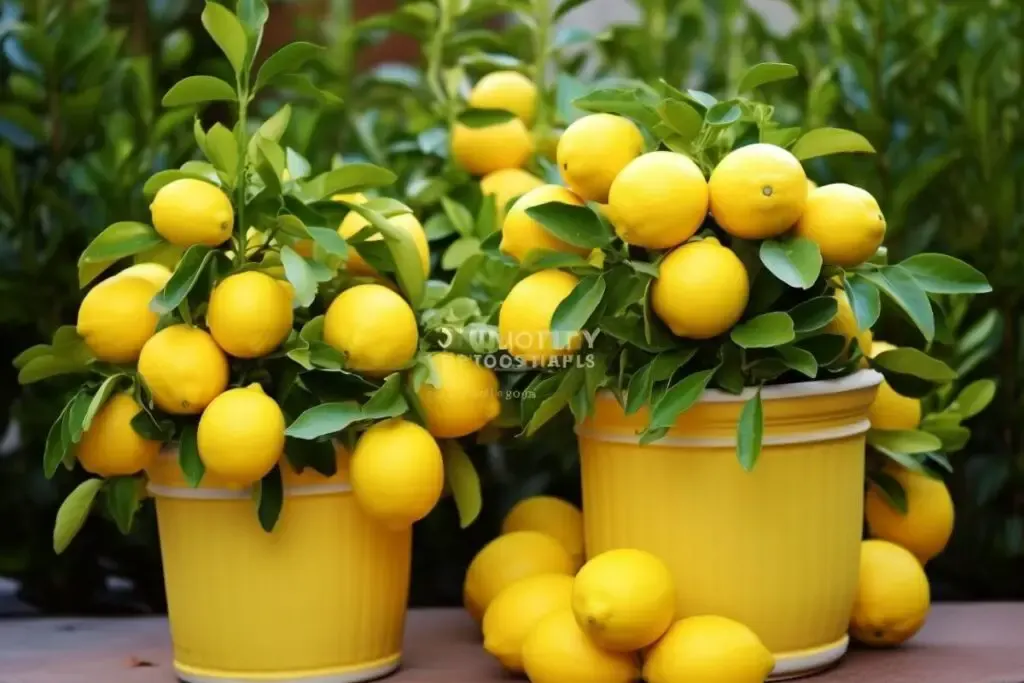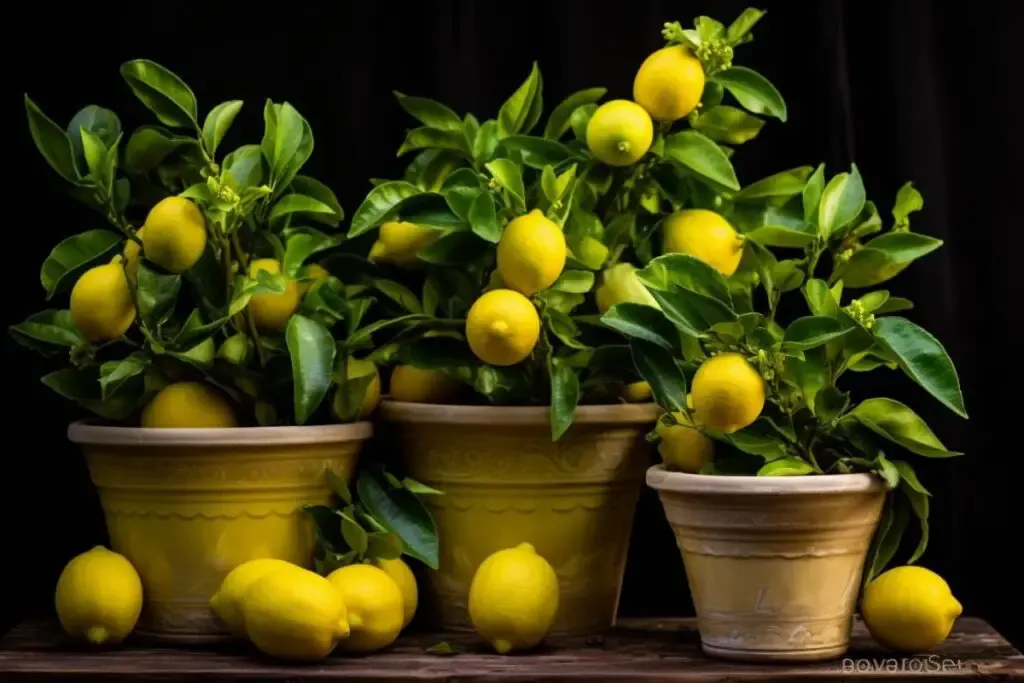Growing lemon trees in pots can bring a slice of the sunny Mediterranean to your patio or indoor space. Not only do these citrus wonders offer fragrant flowers and vibrant fruit, but they’re also surprisingly adaptable to container living.
Whether you’re a seasoned gardener or just starting to flex your green thumb, this guide will help you cultivate your own lemon grove at home—no orchard required.
Do Lemon Trees Grow Well in Pots?
Absolutely! Lemon trees are quite amenable to pot culture. In fact, pots can offer advantages for growers in cooler climates, where lemons aren’t hardy.
Growing lemon trees in pots allows you to control the environment more closely: soil, water, sunlight, and even temperature by moving the tree indoors during chilly spells.
One key to success is choosing the right container. It should be large enough to accommodate growth and have excellent drainage. Your lemon tree’s roots don’t like to sit in water, so a pot that keeps them dry is critical.
Equally important is the soil—well-draining and fertile soil is a must. And let’s not forget about the watering and feeding regime, which will keep your lemon tree healthy and productive.
Now, I know what you might be thinking. Will my potted lemon tree actually bear fruit? With proper care, it will! It may take a few years for a young tree to start producing, but when it does, you’ll have your own home-grown lemons for lemonade, cooking, or a refreshing garnish.
Best Lemon Tree Varieties for Pots
When it comes to selecting a lemon tree for your pot, size and hardiness matter. Dwarf varieties tend to be the go-to because they’re more compact and manageable.
Here are three top picks that I’ve found to thrive in containers:
1. Improved Meyer Lemon

The ‘Improved Meyer’ lemon is a favorite among container gardeners and with good reason. This variety is naturally a bit smaller than your typical lemon tree, making it perfect for pots. It’s also more cold-tolerant than other types, which is great if your climate isn’t all sunshine and rainbows.
‘Improved Meyer’ lemons have a sweeter, less acidic flavor compared to their supermarket cousins, and they’re practically made for homemade lemon pies.
What I love about the ‘Improved Meyer’ is its versatility. It’s not just a fruit-producing plant; it’s a decorative one. Its deep green foliage, white blossoms, and the cheerful yellow of ripening lemons create a beautiful visual display.
2. Ponderosa Lemon

Now, if you’re looking for something with a bit of a wow factor, the ‘Ponderosa’ lemon won’t disappoint. This variety produces impressively large lemons that can reach the size of grapefruits. While it’s not a true dwarf variety, it still grows well in a large pot, and its sizeable fruit is a conversation starter.
I find ‘Ponderosa’ lemon trees to be quite charismatic plants. They’re not just producing fruit; they’re making a statement. Just remember, they need a bit more space to show off their grandeur, so plan your pot and space accordingly.
3. Eureka Lemon

The ‘Eureka’ lemon tree is what many people picture when they think of a classic lemon. It’s the variety you often find in grocery stores.
While it’s a full-size tree, it can be kept smaller with pruning and still produce an abundant crop. ‘Eureka’ is a true lemon with that tart, zesty flavor perfect for almost any lemony dish or beverage.
In a pot, ‘Eureka’ can be quite the performer. It tends to produce its main crop in late winter to early summer, with sporadic fruiting throughout the year. If you’re after that traditional lemon experience, ‘Eureka’ is your go-to.
How to Grow and Care For Lemon Trees in Pots
Caring for lemon trees in pots is not just about enjoying the zesty fruits; it’s about engaging with the plant, understanding its needs, and creating a bond with nature.
Let me guide you through the essentials of growing and caring for these potted sun lovers.
Planting
When planting your lemon tree, think about the long-term relationship you’re starting. Choose a healthy tree from a reputable nursery, looking for one with a strong stem and glossy, vibrant leaves. Planting is best done in the spring, as this gives your tree a full growing season to establish itself.
Begin with a container that has ample drainage holes. I cannot stress enough how critical this is—citrus roots despise soggy conditions. Before you place your tree inside, consider layering the bottom with gravel or broken terracotta pieces to further ensure good drainage.
Pot Size
Starting with a pot that’s too large can lead to water retention in the soil, which is harmful to the tree. Choose a pot that is a few inches larger than the root ball. As the tree grows, you can repot it into a larger container. This gradual “potting-up” method encourages a healthy root system that’s proportionate to the tree’s size.
Light
Lemon trees are like that friend who loves the spotlight—they need full sun to truly thrive. Aim for a spot that receives at least 6-8 hours of direct sunlight daily.
If you’re growing indoors, a south-facing window is ideal, or you might consider supplementing with grow lights during darker months.
Soil
Use a well-draining potting mix formulated for citrus or palms. It should be slightly acidic to match the lemon tree’s natural preferences.
I like to mix in some organic compost for added nutrients, ensuring the mix is loose enough to allow water to pass through easily.
Water
Watering is a bit of an art form. You want to keep the soil moist but not waterlogged. Overwatering is a common pitfall, so check the soil before you water—aim for damp, not soggy.
During the growing season, you’ll water more frequently, while in winter, you’ll scale back.
Temperature and Humidity
Lemon trees enjoy a warmer climate, generally between 70°F and 85°F. They can handle a few dips in temperature, but frost is a definite no-go.
If temperatures drop, bring your potted tree indoors to a cool, bright room. They do appreciate humidity, so if your home runs dry, a humidifier or a pebble tray with water can help.
Fertilizer
Feeding your lemon tree is crucial to its growth and fruit production. Use a fertilizer with a balanced N-P-K ratio, or one specifically formulated for citrus trees.
Slow-release pellets are an excellent hassle-free option, or you can use liquid fertilizer monthly during the growing season. Just ease up on the feeding in the winter when the tree’s growth slows down.
Pruning Potted Lemon Trees
Pruning isn’t just a horticultural technique; it’s a way of communicating with your plant, guiding its growth, and investing in its future bounty. For potted lemon trees, pruning is about balance and beauty, encouraging airflow, sunlight penetration, and a strong, productive structure.
Start by removing any dead, damaged, or diseased branches—these are nothing but a drain on your tree’s resources. Then, look for branches that cross or rub against each other; these can create wounds and entry points for pests or diseases. Make clean cuts just above a leaf node or branch intersection.
Don’t be shy about shaping your tree. Lemon trees can handle a good trim without any fuss. Aim to keep the canopy open and airy, which reduces the risk of fungal diseases and promotes even ripening of fruit. And remember, the best time to prune is in the late winter or early spring before the flush of new growth.
Overwintering
As the season shifts and the cool breath of winter begins to whisper through the leaves, overwintering your lemon tree becomes a priority. If you live in a region where temperatures regularly drop below freezing, you’ll need to transition your tree to a protected space.
An unheated garage or a cool room with a window can serve as a great winter retreat for your potted citrus. The goal is to provide a space that stays above freezing but doesn’t exceed 65°F, as too-warm conditions can trigger new growth that’s vulnerable to damage.
Reduce watering in the winter, allowing the soil to dry out more than you would in the summer. But, don’t let it go bone dry. Your tree is resting, not hibernating, so it still needs life’s essentials, just in smaller doses.
With these care elements in mind, your lemon tree can not only survive but also thrive during the winter months, ready to burst into vigorous growth when the warm season returns. It’s all about providing the right conditions and understanding that even in rest, there’s growth happening beneath the surface.

